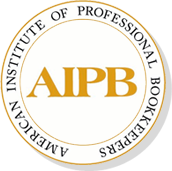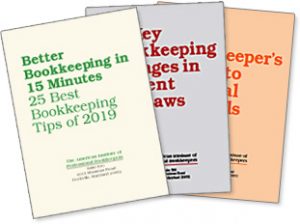The national Certified Bookkeeper (CB) exam covers six subjects. AIPB provides you with all six workbooks to prepare you for the national certification exam. These workbooks not only train you, they drill you on every skill and area of knowledge until you are expert at it.
Here’s an example from Mastering Correction of Accounting Errors, Section 3 – Finding and correcting errors using the unadjusted trial balance.
A transposition error occurs when two digits are reversed, such as 920 entered as 290. If the difference between the debit and credit column totals is exactly divisible by 9 and there is only one error causing the problem, that error may be a transposition. To find a transposition, follow these steps:
Step a. Find the difference between total debits and credits, add 1 to the first digit of the difference, and you have an amount we will call X. You will now investigate every ledger account balance in which the difference between the first and second digits of the balance is X.
For example, assume that the difference between total debits and credits is $540: 5 (first digit of 540) + 1 = 6. You will investigate every ledger account balance where the difference between the first and second digits is exactly 6.
The following example shows how to tell if there is a transposition error. For purposes of illustration, a partial trial balance is shown using account balances without the account titles.
EXAMPLE 1: Here is a partial trial balance for RenCo. For teaching purposes, account balances are shown without account titles.
| Debit | Credit | |||
| $ | 725 | |||
| 620 | ||||
| $ | 115 | |||
| 520 | ||||
| 480 | ||||
| 160 | ||||
| 795 | ||||
| 737 | ||||
| 808 | ||||
| $ | 2,300 | $ | 2,660 | |
2,660 total credits – $2,300 total debits = $360 difference. Is the difference divisible by 9? 360/9 = 40. Yes, so the error is probably a transposition or slide (a “0” inadvertently added to or deleted from the amount) You found no slide error, so you must check for a transposition.
3 (first digit of $360) + 1 = 4. Investigate all account balances in which the difference between the first and second digits is 4.
Step b. See if correcting the error will increase (I) or decrease (D) the debit or credit total.
| Total debits | Total credits | |||
| $ | 2,300 | $ | 2,660 | |
Three accounts must be investigated: the debit balance of $620 (6 – 2 = 4) and the two credit balances, of $480 (8 – 4 = 4) and $737 (7 – 3 = 4).
Debit balance:
$620—-620 – 260 = 360 D
If $620 is a transposition of $260, correcting it will decrease total debits by $360, so it is marked with a D. This account cannot be the cause of the error because total debits are already less than total credits, and decreasing total debits would only enlarge the error. You move on to the credit balances.
Credit balances:
$480—-840 – 480 = 360 I
$737—–773 – 737 = 36 I
or———737 – 377 = 360 D
If $480 is a transposition of $840, correcting it will increase total credits, so it is marked with an I. This account cannot be the cause of the problem because total credits are already more than total debits (increasing total credits would enlarge the error).
If $737 is a transposition of $773, correcting it will increase total credits, so it is marked with an I. This account cannot be the cause of the problem because the difference is only 36, not 360.
If $737 is a transposition of $377, correcting it will decrease total credits by $360. To compute: $2,660 total credits – $360 = $2,300. Because total debits are $2,300, the transposition may be what is causing the problem.
At the end of every section of each self-study workbook you get a double-quiz to make sure you lock in every bit of knowledge and every on-the-job skill.
Why not use this precious time? Become a CB now.
To get started, discover what to study for the national Certified Bookkeeper exam.
Try a no-risk membership and see what it can do for you. If not completely satisfied, cancel for a refund. Join now and get:
- The General Ledger digital newsletter every month—free.
- Free use of our telephone Member AnswerLine, where experienced accountants answer your everyday bookkeeping and payroll questions.
- Free answers to your QuickBooks questions from experts on our Member AnswerLine.
- Discounts on self-study courses in payroll, adjusting entries, depreciation and other skills . . . plus: you get other professional discounts.
Join now and you also get 3 special reports, free:
- 21 Key Bookkeeping Changes in Current Tax Laws—free!
- Better Bookkeeping in 15 Minutes—the best bookkeeping tips of 2019—free!
- The Bookkeeper’s Guide to Internal Controls–free!
Enjoy member benefits, such as:
- Free telephone Member AnswerLine, where experienced accountants answer your everyday bookkeeping and payroll questions
- Discounts of up to 34% on UPS shipping services.
- Discounts on continuing professional education.
- Discounts on professional liability insurance.
Get the recognition you deserve, and stay up to date. Join bookkeepers nationwide as a member of The American Institute of Professional Bookkeepers. Join now.


